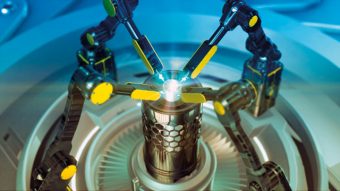
Nick Barrett, Editor
nick@maintenanceandengineering.com
@MaintOnLine
There will be a lot of uncomfortable squirming in seats as engineers and other skilled workers read about a new report from investment bank Goldman Sachs. The bank’s research says that the latest breakthroughs in artificial intelligence could lead to the automation of a quarter of the work done in the US and eurozone, replacing not just the lower skilled tasks that have always looked most vulnerable, but also those of employees previously regarded as relatively immune to redundancy.
Goldman Sachs says generative AI systems such as ChatGP which can create content indistinguishable from human output could spark a productivity boom that would raise annual global gross domestic product by 7% over 10 years. The cost would be that some 7% of workers in the United States, for example, could see about half of their work done by generative artificial intelligence. Not all of these jobs would survive.
The technology would bring “significant disruption” to the labour market, says Goldman Sachs, exposing 300 million full-time jobs to redundancy. Workers like lawyers and administrative staff are predicted to be at greatest risk of redundancy, but the leap forward in automation could affect a lot more.

The researchers say that some two-thirds of jobs in the US and Europe are exposed to some degree of AI automation, their outlook being based on data on the tasks typically performed in many occupations. Goldman’s estimates of the impact are actually more conservative than some academic studies which examined the potential impact of a wider range of technologies.
On the bright side, Goldman Sachs concedes that most people would see less than half of their workload automated and could expect to continue in their jobs, and some of their time reallocated to more productive activities.
Some 30% of those working in physical or outdoor jobs – including maintenance operations and activities like on-site construction work – would be unaffected. But even they might see their work come under threat from other forms of automation.
But about 7% of US workers are in jobs where at least half of their tasks could be done by generative AI and are vulnerable to replacement. The research suggests that there would be a similar impact in Europe. Globally Goldman Sachs estimates that about 20% of work could be carried out by AI, representing some 300 million full-time jobs across the major economies.
Without becoming either all Luddite about this research, or jumping for joy at the prospect of a work free world where we can all enjoy more leisure time, this report should be welcomed as a warning that something big is going to happen in the world of work as a result of technological developments, and it is time to start thinking about how societies and companies can adapt to the new opportunities as well as challenges it will create.
On the positive side AI technologies seem to have potential to revive the industrialised world’s flagging productivity growth. Goldman Sachs cites a study from last year by economists that argued 60% of workers are now employed in occupations that did not exist in 1940, which implied that over 85% of employment growth over the last 80 years is explained by the technology-driven creation of new jobs.
But the downside could still be creation of a class of dispossessed white-collar workers. Manufacturing of course has felt the impact of automation on workforces since the 1980’s, so should know what to expect. But memories are short and this time it really could be different – and not necessarily in a good way.
Slow technology uptake revealed in survey
Much of the above forecast will of course depend on how quickly manufacturers and other companies take up the new technologies being offered. Some otherwise fairly depressing results of a survey by MakeUK and Infor offer some cheer to those hoping to hold onto their jobs as a tide of automation and digital technology change washes over them.
The survey asked manufacturers about how they were adopting digital technologies to monitor the resilience of their supply chains. Encouragingly, 82% of companies said they believe monitoring suppliers is critical to their business; but there is a lag between citing its importance and using digital technologies that can enhance monitoring.
The survey found that while dashboard and analytics are the most popular digital tool for 46% of companies, there is minimal take up of technologies such as AI and machine learning – 8%, robotics and automation – 7 %, and augmented and virtual reality – 4%. Some 40% of companies don’t use technology at all to monitor their supply chains, while around 25% either don’t monitor up or don’t monitor down their supply chains.
Fewer than 14% are taking advantage of the most advanced capabilities, including real-time sensors, automation, artificial intelligence and machine learning, but it is these under deployed technologies that hold the greatest potential in delivering real value. So keep your tin hats handy and polished, but we might not need them for a while.

